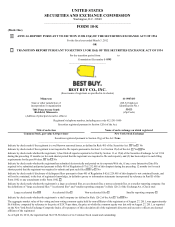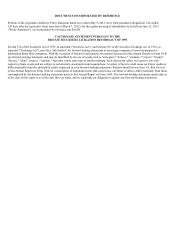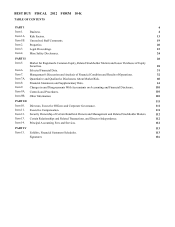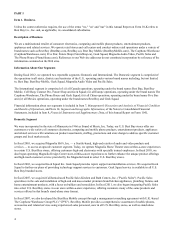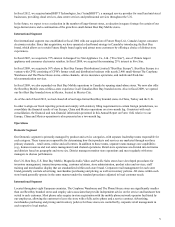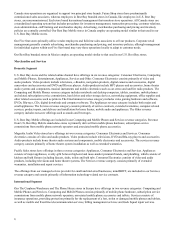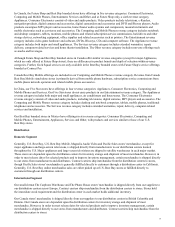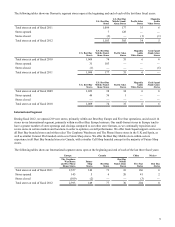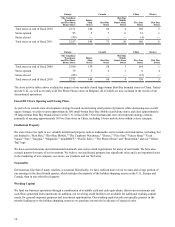Best Buy 2012 Annual Report Download - page 11
Download and view the complete annual report
Please find page 11 of the 2012 Best Buy annual report below. You can navigate through the pages in the report by either clicking on the pages listed below, or by using the keyword search tool below to find specific information within the annual report.11
Customers
We do not have a significant concentration of sales with any individual customer and, therefore, the loss of any one customer
would not have a material impact on our business. No single customer has accounted for 10% or more of our total revenue.
Backlog
Our stores, call centers and online shopping sites do not have a material amount of backlog orders.
Government Contracts
No material portion of our business is subject to renegotiation of profits or termination of contracts or subcontracts at the
election of any government or government agencies or affiliates.
Competition
Our primary competitors are consumer electronics retailers including vendors who offer their products direct to the consumer,
internet-based businesses, wholesale clubs, discount chains and home-improvement superstores.
Some of our competitors operate low cost operating structures and seek to compete for sales purely on price. In addition, in the
U.S., internet-only operators receive an exemption from collecting sales taxes for sales in certain states. We believe this
advantage will continue to be eroded as sales tax rules are re-evaluated at both the state and federal level. We carefully monitor
pricing offered by our competitors and continuously adjust our pricing and promotions to maintain our competitiveness. In
most of our locations, we offer some form of price-match to our store-based competitors. In order to allow this, we are focused
on maintaining efficient operations, leveraging the economies of scale available to us and our global vendor partnerships.
In addition to price, we believe our ability to deliver a high quality customer experience offers us a key competitive advantage.
We believe our dedicated and knowledgeable people, integrated store and online channels, broad product assortment, range of
focused service and support offerings, distinct store formats and brand marketing strategies are important ways in which we
maintain this advantage.
Research and Development
We have not engaged in any material research and development activities during the past three fiscal years.
Environmental Matters
While seeking and discovering new and innovative ways to engage our customers in the connected world, we also strive to
lessen our impact on the environment. Our energy efficiency strategy includes end-to-end efforts to reduce energy use in our
own internal operations and of the products and services we offer our customers. And with an expanding selection of our
internally developed exclusive brand products, we continue to make efforts to provide products that use less energy, are made
of non-toxic materials and are packaged in more responsible ways.
Our energy efficient practices include a centralized automated energy management system for our U.S. Best Buy stores and
retail energy reports by store. We continue to evolve our High Performance Building Program as we remodel and update
locations. For example, where economically viable, during remodels we are installing skylights and dimmable lighting which
enables us to reduce our energy consumption. These energy efficiency improvements, as well as process enhancements, have
helped us reduce our own carbon footprint. In calendar 2010, we set a new long-term goal of reducing our carbon dioxide
emissions by 20% by calendar 2020 (over a 2009 baseline). During calendar 2011, our retail stores, distribution centers and
corporate offices reduced over 59,000 metric tons of carbon dioxide (CO2) emissions, an “absolute” decrease of 7.5% from the
previous calendar year.
We continue to experience consumer demand for environmentally-friendly products and services, which leads us to focus on
providing energy efficient products and a means to recycle old products. Our U.S. Best Buy customers purchased over 24
million ENERGY STAR® qualified products in calendar 2011. Through our ENERGY STAR® program, we helped our
customers realize utility bill savings of over $143 million in calendar 2011. This energy savings equates to just over 2 billion
pounds of CO2 avoidance, or the equivalent of removing 180,000 cars from the road. We are also investing in a number of
technologies and partnerships that increase our product and service offerings to our customers including: home automation;
alternative fuel sources and transportation; and partnerships with utility companies in 23 states in the U.S. that will allow for
more affordable consumer purchases of energy efficient products.

